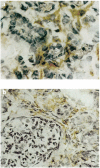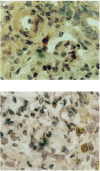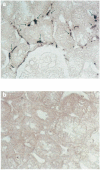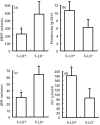Gene expression of 5-lipoxygenase and LTA4 hydrolase in renal tissue of nephrotic syndrome patients
- PMID: 10337029
- PMCID: PMC1905289
- DOI: 10.1046/j.1365-2249.1999.00858.x
Gene expression of 5-lipoxygenase and LTA4 hydrolase in renal tissue of nephrotic syndrome patients
Abstract
Leukotrienes (LT) of the 5-lipoxygenase pathway constitute a class of potent biological lipid mediators of inflammation implicated in the pathogenesis of different models of experimental glomerulonephritis. The key enzyme, 5-lipoxygenase (5-LO), catalyses oxygenation of arachidonic acid to generate the primary leukotriene LTA4. This LT, in turn, serves as a substrate for either LTA4 hydrolase, to form the potent chemoattractant LTB4, or LTC4 synthase, to produce the powerful vasoconstrictor LTC4. To investigate the potential role of LT in the pathogenesis of human glomerulonephritis with nephrotic syndrome, we examined the gene expression of 5-LO and LTA4 hydrolase in renal tissue of 21 adult patients with nephrotic syndrome and 11 controls. The patients consisted of 11 cases of membranous nephropathy (MN), seven focal and segmental glomerulosclerosis (FSGS), two non-IgA mesangial glomerulonephritis and one minimal change disease. Total RNA purified from renal tissue was reverse transcribed into cDNA and amplified with specific primers in a polymerase chain reaction (RT-PCR). Eight patients' renal tissue, four MN and four FSGS, co-expressed 5-LO and LTA4 hydrolase. In situ hybridization analysis revealed 5-LO expression and distribution limited to the interstitial cells surrounding the peritubular capillaries. Comparative clinical and immunohistological data showed that these eight patients had impaired renal function and interstitial changes that significantly correlated with 5-LO expression. These findings suggest that leukotrienes may play an important role in the pathogenesis of MN and FSGS. These results are also relevant to elucidating the pathophysiologic mechanisms which underlie progression to renal failure in these diseases.
Figures





Similar articles
-
5-Lipoxygenase and leukotriene A4 hydrolase expression in primary nephrotic syndrome.Pediatr Nephrol. 2004 Apr;19(4):396-9. doi: 10.1007/s00467-003-1399-3. Epub 2004 Feb 21. Pediatr Nephrol. 2004. PMID: 14986086
-
Determination of the contribution of cysteinyl leukotrienes and leukotriene B4 in acute inflammatory responses using 5-lipoxygenase- and leukotriene A4 hydrolase-deficient mice.J Immunol. 1999 Dec 15;163(12):6810-9. J Immunol. 1999. PMID: 10586081
-
Enzymes functional in the syntheses of leukotrienes and related compounds.Int J Biochem. 1988;20(7):661-6. doi: 10.1016/0020-711x(88)90160-7. Int J Biochem. 1988. PMID: 2846379 Review.
-
Effect of dexamethasone on leukotriene synthesis in DMSO-stimulated HL-60 cells.Prostaglandins Leukot Essent Fatty Acids. 1998 Dec;59(6):385-93. doi: 10.1016/s0952-3278(98)90100-4. Prostaglandins Leukot Essent Fatty Acids. 1998. PMID: 10102384
-
Significance of leukotriene-A4 hydrolase in the pathogenesis of psoriasis.Skin Pharmacol. 1997;10(4):169-77. doi: 10.1159/000211501. Skin Pharmacol. 1997. PMID: 9413890 Review.
Cited by
-
Deconvolution of Focal Segmental Glomerulosclerosis Pathophysiology Using Transcriptomics Techniques.Glomerular Dis. 2021 Jul 14;1(4):265-276. doi: 10.1159/000518404. eCollection 2021 Oct. Glomerular Dis. 2021. PMID: 36751384 Free PMC article. Review.
-
Serum oxylipin profiles in IgA nephropathy patients reflect kidney functional alterations.Metabolomics. 2012 Dec;8(6):1102-1113. doi: 10.1007/s11306-012-0417-5. Metabolomics. 2012. PMID: 23833568 Free PMC article.
-
5-Lipoxygenase and leukotriene A4 hydrolase expression in primary nephrotic syndrome.Pediatr Nephrol. 2004 Apr;19(4):396-9. doi: 10.1007/s00467-003-1399-3. Epub 2004 Feb 21. Pediatr Nephrol. 2004. PMID: 14986086
-
Physiological and molecular effects of interleukin-18 administration on the mouse kidney.J Transl Med. 2018 Mar 7;16(1):51. doi: 10.1186/s12967-018-1426-6. J Transl Med. 2018. PMID: 29514661 Free PMC article.
-
Autosomal Recessive Congenital Ichthyosis and Steroid-Resistant Nephrotic Syndrome due to Homozygous Mutation in the ALOX12B gene: A Novel Association with Review of Literature.J Pediatr Genet. 2020 Oct 19;11(1):28-33. doi: 10.1055/s-0040-1718725. eCollection 2022 Mar. J Pediatr Genet. 2020. PMID: 35186387 Free PMC article.
References
-
- Wehrmann M, Bohle A, Bogensch TZO, et al. Long-term prognosis of chronic idiopathic membranous glomerulonephritis. Clin Nephrol. 1989;31:67–76. - PubMed
-
- Abe S, Amagasaki Y, Iyori S, Konishi K, Kato E, Sagakuchi H. Significance of tubulointerstitial lesions in biopsy specimens of glomerulonephritic patients. Am J Nephrol. 1989;9:30–37. - PubMed
-
- Wang H, Tomino Y, Fukui M, et al. Correlation between tubulointerstitial changes and prognosis in patients with primary membranous nephropathy. Nephron. 1994;67:362. - PubMed
-
- Salant DJ, Quigg RJ, Cybulsky AV. Heymann nephritis: mechanism of renal injury. Kidney Int. 1989;35:976–84. - PubMed
-
- Gabbai FB, Gushwa LC, Wilson CB, Blantz RC. An evaluation of the development of experimental membranous nephropathy. Kidney Int. 1987;31:1267–78. - PubMed
Publication types
MeSH terms
Substances
LinkOut - more resources
Full Text Sources
Other Literature Sources
Miscellaneous

